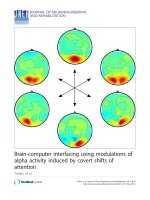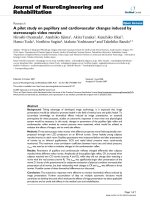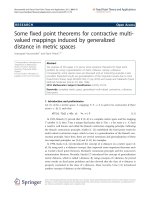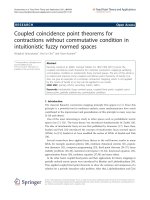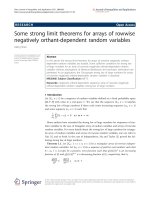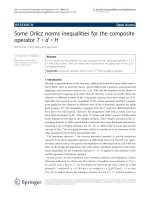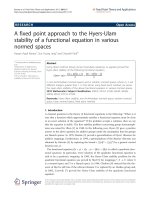Báo cáo hóa học: " Some fixed point theorems for contractive multivalued mappings induced by generalized distance in metric spaces" pptx
Bạn đang xem bản rút gọn của tài liệu. Xem và tải ngay bản đầy đủ của tài liệu tại đây (272.47 KB, 10 trang )
RESEARC H Open Access
Some fixed point theorems for contractive multi-
valued mappings induced by generalized
distance in metric spaces
Soawapak Hirunworakit
1
and Narin Petrot
1,2*
* Correspondence:
1
Department of Mathematics,
Faculty of Science, Naresuan
University, Phitsanulok 65000,
Thailand
Full list of author information is
available at the end of the article
Abstract
The purpose of this paper is to prove some existence theorems for fixed point
problem by using a generalization of metric distance, namely u-distance.
Consequently, some special cases are discussed and an interesting example is also
provided. Presented results are generalizations of the important results due to Ume
(Fixed Point Theory Appl 2010(397150), 21 pp, 2010) and Suzuki and Takahashi (Topol
Methods Nonlinear Anal 8, 371-382, 1996).
2010 Mathematics Subject Classification: 47H09, 47H10.
Keywords: complete metric space, generalized multi-valued contractive, u-distance,
fixed point.
1. Introduction and preliminaries
Let (X, d) be a metric space. A mapping T: X ® X is said to be contraction if there
exists r Î [0, 1) such that
d(T(x), T(y)) ≤ rd(x, y), ∀x, y ∈ X.
(1:1)
In 1922, Banach [1] proved that if (X, d) is a complete metric space and the mapping
T satisfies (1.1), then T has a unique fixed point, that is T(u)=u for some u Î X. Such
a result is well known and called the Banach contraction mapping principle. Following
the Banach contraction principle, Nadler Jr. [2] established the fixed point result for
multi-valued contraction maps, which in turn is a generalization of the Banach con-
traction principle. Since then, there are several extensions and generalizations of these
two important principles, see [3,4] and [5-11] for examples.
In 1996, Kada et al. [4] introduced the concept of w-distance on a metric space (X,
d). By using such a w-distance concept, they improved some important theorems such
as Caristi’s fixed point theorem, Ekeland’s variational principle and the nonconvex
minimization theorem. Recently, Suzuki [7] introduced the conce pt of generalization
metric distance, which is called τ-distance. By using concepts of τ-distance, he proved
some results on fixed point problems and also showed that the class of w-distance is
properly contained in the class of τ-distance. Most recently, Ume [11] introduced
another concept of distance as the following.
Hirunworakit and Petrot Fixed Point Theory and Applications 2011, 2011:78
/>© 2011 Hiru nworakit and Petrot; licensee Springer. This is an Open Access article distributed under the terms of the Creative Commons
Attribution License (http://creativecommons.o rg/licenses/by/2.0), which permits unrestricted use, distribution, and reproduction in
any medium, provided the original work is properly cited.
Definition 1.1.[11].Let(X, d) be a metric space. Then, a fun ction p: X × X ® [0,
∞) is called u-distance on X if there exists a function θ: X×X×[0, ∞) × [0, ∞) ® [0,
∞) such that
(u1) p(x, z) ≤ p(x, y)+p(y, z) for all x, y, z Î X;
(u 2) θ(x, y,0,0)=0andθ(x, y, s, t) ≥ min{s, t}forallx, y Î X and s, t Î [0, ∞),
and for any x Î X and for every ε >0
,thereexistsδ >0suchthat|s - s
0
| <δ, |t -
t
0
|<δ, s, s
0
, t, t
0
Î [0, ∞) and y Î X imply
|
θ
(
x, y, s, t
)
− θ
(
x, y, s
0
, t
0
)
| <ε
;
(1:2)
(u3)
lim
n→∞
x
n
= x ,
lim
n→∞
sup{θ (w
n
, z
n
, p(w
n
, x
m
), p(z
n
, x
m
)) : m ≥ n} =0
(1:3)
imply
p(y, x) ≤ lim inf
n→∞
p(y, x
n
)forally ∈ X;
(1:4)
(u4)
lim
n→∞
sup{p(x
n
, w
m
):m ≥ n} =0,
lim
n→∞
sup{p(y
n
, z
m
):m ≥ n} =0,
lim
n→∞
θ(x
n
, w
n
, s
n
, t
n
)=0,
lim
n→∞
θ(y
n
, z
n
, s
n
, t
n
)=0
(1:5)
imply
lim
n→∞
θ(w
n
, z
n
, s
n
, t
n
)=0
(1:6)
or
lim
n→∞
sup{p(w
m
, x
n
):m ≥ n} =0,
lim
n→∞
sup{p(z
m
, y
n
):m ≥ n} =0,
lim
n→∞
θ(x
n
, w
n
, s
n
, t
n
)=0,
lim
n→∞
θ(y
n
, z
n
, s
n
, t
n
)=0
(1:7)
Hirunworakit and Petrot Fixed Point Theory and Applications 2011, 2011:78
/>Page 2 of 10
imply
lim
n→∞
θ(w
n
, z
n
, s
n
, t
n
)=0;
(1:8)
(u5)
lim
n→∞
θ(w
n
, z
n
, p(w
n
, x
n
), p(z
n
, x
n
)) = 0,
lim
n→∞
θ(w
n
, z
n
, p(w
n
, y
n
), p(z
n
, y
n
)) = 0
(1:9)
imply
lim
n→∞
d(x
n
, y
n
)=0
(1:10)
or
lim
n→∞
θ(a
n
, b
n
, p(x
n
, a
n
), p(x
n
, b
n
)) = 0,
lim
n→∞
θ(a
n
, b
n
, p(y
n
, a
n
), p(y
n
, b
n
)) = 0
(1:11)
imply
lim
n→∞
d(x
n
, y
n
)=0.
(1:12)
We give the following remark and example, which can be found in [11].
Remark 1.2. Suppo se that θ:X×X×[0, ∞) × [0, ∞) ® [0, ∞) is a mapping sati sfy-
ing (u2) ~ (u5). Then, there exists a mapping h:X×X×[0, ∞) × [0, ∞) ® [0, ∞) such
that h is nondecreasing in its third and fourth variable, respectively, satisfying (u2)h ~
(u5)h, where (u2)h ~ (u5)h stand for substituting h for θ in (u2) ~ (u5), respectively.
Example 1.3. Let p be a τ-distance on metric space (X, d), then p is also a u-distance
on X. On the other hand, let (X, || · ||) be a normed space then a function p:X×X®
[0, ∞) defined by p(x, y)=||x|| for every x, y Î X is
a u-distance on X but not a τ-dis-
tance. These imply that the class of τ-distance is properly contained in the class of u-
distance.
In this paper, we will prove some fixed point theorems in metric spaces by using
such a u-distance concept. Consequently, as shown by Example 1.3, our result s gener-
alize many of the existing results presented in metric spaces. Indeed, it provides more
choices of tool implements to check whether a fixed point of considered mapping
exists.
Our main results are concerned with the following class of mappings.
Definition 1.4.Let(X, d) be a metric space and 2
X
be a set of all nonempty subset
of X. A multi-valued mapping T: X ® 2
X
is called p-contractive if there exist a u-
Hirunworakit and Petrot Fixed Point Theory and Applications 2011, 2011:78
/>Page 3 of 10
distance p on X and r Î [0, 1) such that for any x
1
, x
2
Î X and y
1
Î T(x
1
) there is y
2
Î
T(x
2
) such that
p(y
1
, y
2
) ≤ rp(x
1
, x
2
).
(1:13)
Remark 1.5. Definition 1.4 was introduced and its fixed point theorems were proved
in [9], but by using the concept of w-distance. Note that in the case p = d, the map-
ping T is called a contraction.
We now recall some basic concepts and well-known results.
Definition 1.6.[11].Let(X , d) be a metric space and p be a u-distance on X.Then,
asequence{x
n
}ofX is called p-Cauchy sequence if there exists a sequence {z
n
}ofX
such that
lim
n→∞
sup{θ (z
n
, z
n
, p(z
n
, x
m
), p(z
n
, x
m
)) : m ≥ n} =0,
(1:14)
or
lim
n→∞
sup{θ (z
n
, z
n
, p(x
m
, z
n
), p(x
m
, z
n
)) : m ≥ n} =0.
(1:15)
where θ:X×X×[0, ∞) × [0, ∞) ® [0, ∞) is a function satisfying (u2) ~ (u5) for a u-
distance p.
Lemma 1.7. [11]. Let (X, d) be a metric space and let p be a u-distance on X.Sup-
pose that a sequence {x
n
}ofX satisfies
lim
n→∞
sup{p(x
n
, x
m
):m ≥ n} =0.
(1:16)
or
lim
n→∞
sup{p(x
m
, x
n
):m ≥ n} =0.
(1:17)
Then, {x
n
}isap-Cauchy sequence.
Lemma 1.8. [11]. Let (X, d) be a metric space and let p be a u-distance on X.If{x
n
}
is a p-Cauchy sequence, then {x
n
} is a Cauchy sequence.
Lemma 1.9.[11].Let(X, d) be a metric space and let p be a u-distance on X.Letx,
y Î X. If there exists z Î X such that p(z, x) = 0 and p(z, y) = 0, then x = y.
Definition 1.10. Let (X, d) be a metric space and T: X ® 2
X
be a mapping. For any
fixed x
0
Î X, a sequ ence {x
n
}={x
0
, x
1
, x
2
, } ⊂ X such that x
n+1
Î T (x
n
) is called an
orbit of x
0
with respect to mapping T. We will denote by
O(T, x
0
)
the set of all orbital
sequences of x
0
with respect to mapping T.
2. Main results
From now on, in view of Remark 1.2, if θ:X×X×[0, ∞) × [0, ∞) ® [0, ∞) is a map-
ping satisfying (u2) ~ (u5) for the considered u-distance, we will always understand
that θ is a nondecreasing function in its third and fourth variables.
Inspired by an idea presented by Suzuki [8], we have an important tool for proving
our main result.
Lemma 2.1. Let (X, d) be a metric space and let p be a u-distance on X. If {x
n
} is a
p-Cauchy sequence and {y
n
} is a sequence satisfying
lim
n→∞
sup{p(x
n
, y
m
):m ≥ n} =0,
(2:1)
Hirunworakit and Petrot Fixed Point Theory and Applications 2011, 2011:78
/>Page 4 of 10
then {y
n
} is also a p-Cauchy sequence and
lim
n→∞
d(x
n
, y
n
)=0
.
Proof.Letθ :X×X×[0, ∞) × [0, ∞) ® [0, ∞) satisfying (u2) ~ (u5) for a u-distance
p. Since {x
n
}isap-Cauchy sequence, there exists a sequence {z
n
}ofX such that
lim
n→∞
sup{θ (z
n
, z
n
, p(z
n
, x
m
), p(z
n
, x
m
):m ≥ n} =0.
(2:2)
Now, let {y
n
} be a sequence satisfying
lim
n→∞
sup{p(x
n
, y
m
):m ≥ n} =0
. Let us put
α
n
=sup{p(z
n
, x
m
):m ≥ n},
and
β
n
=sup{p(x
i
, y
j
):j > i ≥ n}.
We note that {b
n
} is a nonincreasing sequence and converge to 0. Thus, from (u2)
we can define a strictly increasing function f from N into itself such that
θ(z
n
, z
n
, α
n
+ β
f (n)
, α
n
+ β
f (n)
) ≤ θ( z
n
, z
n
, α
n
, α
n
)+
1
n
,
(2:3)
for all n Î N. Using such a function f, we now define a function g: N ® N by
g(n)=
1, if n < f (1),
k,iff (k) ≤ n < f (k +1) forsomek ∈
.
Then, we can see that
• g(n) ≤ f (g(n)) ≤ n for all n Î N with g(n) ≥ 2.
•
θ(z
g(n)
, z
g(n)
, α
g(n)
+ β
n
, α
g(n)
+ β
n
) ≤ θ( z
g(n)
, z
g(n)
, α
g(n)
, α
g(n)
)+
1
g(n)
.
•
lim
n→∞
g(n)=∞
.
Now we consider
lim sup
n→∞
sup{θ (z
g(n)
, z
g(n)
, p(z
g(n)
, y
m
), p(z
g(n)
, y
m
)) : m ≥ n}
≤ lim sup
n→∞
sup{θ (z
g(n)
, z
g(n)
, p(z
g(n)
, x
n
)+p(x
n
, y
m
), p(z
g(n)
, x
n
)+p(x
n
, y
m
)) : m ≥ n}
≤ lim sup
n→∞
θ(z
g(n)
, z
g(n)
, α
g(n)
+ β
n
, α
g(n)
+ β
n
)
≤ lim
n→∞
θ(z
g(n)
, z
g(n)
, α
g(n)
, α
g(n)
)+
1
g(n)
=0.
This means {y
n
}isap-Cauchy sequence. Furthermore, since
lim sup
n→∞
θ(z
g(n)
, z
g(n)
, p(z
g(n)
, x
n
), p(z
g(n)
, x
n
)) ≤ lim
n→∞
θ(z
g(n)
, z
g(n)
, α
g(n)
, α
g(n)
)=0,
we have
lim
n→∞
d(x
n
, y
n
)=0
,by(u5). This completes the proof. □
Now we present our main results, which are related to p-contractive mapping.
Lemma 2.2. Let (X, d) be a metric space and let T: X ® 2
X
be a p-contr active map-
ping. Then, for each u
0
Î X, there exists an orbit
{u
n
}∈O(T, u
0
)
such that
Hirunworakit and Petrot Fixed Point Theory and Applications 2011, 2011:78
/>Page 5 of 10
lim
n→∞
sup{p(u
n
, u
m
):m ≥ n} =0.
(2:4)
Consequently,{u
n
} is a p-Cauchy sequence.
Proof.Letu
0
Î X be arbitrary and u
1
Î T(u
0
) be chosen. Then, by T as a p-contrac-
tive mapping, there exists u
2
Î T(u
1
) such that
p(u
1
, u
2
) ≤ rp(u
0
, u
1
).
For this u
2
Î T( u
1
), again by T as a p-contractive, we can find u
3
Î T(u
2
) such that
p(u
2
, u
3
) ≤ rp(u
1
, u
2
).
Continuing this process, we obtain a sequence {u
n
}inX such that u
n+1
Î T(u
n
) and
p(u
n
, u
n+1
) ≤ rp(u
n−1
, u
n
), for all n ∈ .
Notice that we have
p(u
n
, u
n+1
) ≤ rp(u
n−1
, u
n
) ≤ r
2
p(u
n−2
, u
n−1
) ≤ ···≤ r
n
p(u
0
, u
1
),
for each n Î N. This gives,
p(u
n
, u
m
) ≤ p(u
n
, u
n+1
)+p(u
n+1
, u
n+2
)+···+ p(u
m−1
, u
m
)
≤ r
n
p(u
0
, u
1
)+r
n+1
p(u
0
, u
1
)+···+ r
m−1
p(u
0
, u
1
)
≤
r
n
1 − r
p(u
0
, u
1
),
(2:5)
where n, m Î N with m ≥ n. Consequently,
0 ≤ lim
n→∞
sup{p(u
n
, u
m
):m ≥ n}≤ lim
n→∞
r
n
1 − r
p(u
0
, u
1
)=0.
(2:6)
This proves the first part of this lemma. Furthermore, the second part is followed
from (2.6) and Lemma 1.7. □
Lemma 2.3. Let (X, d) b e a complete metric space and T: X ® 2
X
be a p-contractive
mapping. Then, there exist a sequence {w
n
} and v
0
in × such that {w
n
} ⊂ T(v
0
) and
{w
n
} converges to v
0
.
Proof. Let θ:X×X×[0, ∞) × [0, ∞) ® [0, ∞) be a mapping satisfying (u2) ~ (u5) for
this u-distance p.
Let u
0
Î X be chosen. By Lemma 2.2, we know that there exists
{u
n
}∈O(T, u
0
)
such that {u
n
}isap-Cauchy sequence. Moreover, it satisfies
p(u
n
, u
m
) ≤
r
n
1 − r
p(u
0
, u
1
),
(2:7)
where n, m Î N with m ≥ n. Since {u
n
}isap-Cauchy sequence in a metric complete
space (X, d), it is a convergent sequence, say lim
n®∞
u
n
= v
0
, for some v
0
Î X. Conse-
quently, by (u
3
) and (2.7), we have
p(u
n
, v
0
) ≤ lim inf
m→∞
p(u
n
, u
m
) ≤
r
n
1 − r
p(u
0
, u
1
).
(2:8)
For this v
0
Î X, by using the p-contractiveness of mapping T, we can find a sequence
{w
n
}inT(v
0
) such that
Hirunworakit and Petrot Fixed Point Theory and Applications 2011, 2011:78
/>Page 6 of 10
p(u
n
, w
n
) ≤ rp(u
n−1
, v
0
).
It follows that
p(u
n
, w
n
) ≤ rp(u
n−1
, v
0
) ≤
r
n
1 − r
p(u
0
, u
1
),
(2:9)
for any n Î N.
Now we show that {w
n
}convergestov
0
. In fact, since θ is a nondecreasing function
in its third and fourth variables, then (2.8) and (2.9) imply
lim
n→∞
θ(u
n
, u
n
, p(u
n
, v
0
), p(u
n
, v
0
)) = 0,
and
lim
n→∞
θ(u
n
, u
n
, p(u
n
, w
n
), p(u
n
, w
n
)) = 0.
Hence, by (u5), we conclude that lim
n®∞
d(v
0
, w
n
)=0.Thismeansthat{w
n
}con-
verges to v
0
, and the proof is completed. □
For a metric space (X, d), we will denote by Cl(X) the set of all closed subsets of X.
In view of proving Lemma 2.3, we can obtain a fixed point theorem in the general
metric space setting.
Theorem 2.4. Let (X, d) be a metric space and T: X ® 2
X
be a p-cont racti ve map-
ping. If there exist u
0
, v
0
Î X and
{u
n
}∈O(T, u
0
)
such that
(i)
lim
n→∞
p(u
n
, v
0
)=0
;
(ii)
T(v
0
) ∈ Cl(X)
.
Then, F(T) ≠ Ø. Furthermore, v
0
Î F (T).
Next, we provide some fixed point theorems for p-contractive mapping in a complete
metric space. □
Theorem 2.5. Let (X, d) be a complete metric space and T: X ® Cl(X) be a p-con-
tractive mapping. Then, there exists v
0
Î X such that v
0
Î T (v
0
) and p(v
0
, v
0
)=0.
Proof. Let u
0
Î X be chosen. From Lemma 2.2 and Theorem 2.4, we know that there
exist a p-Cauchy sequence
{u
n
}∈O(T, u
0
)
and v
0
Î F(T)suchthat{u
n
}convergesto
v
0
,
lim
n→∞
sup{p(u
n
, u
m
):m ≥ n} =0,
(2:10)
and
p(u
n
, v
0
) ≤
r
n
1 − r
p(u
0
, u
1
).
(2:11)
Wenowshowthatp(v
0
, v
0
)=0.Observethat,sinceT is a p-contractive mapping
and v
0
Î T (v
0
), we can find v
1
Î T (v
0
) such that
p(v
0
, v
1
) ≤ rp(v
0
, v
0
).
In fact, by using this process, we can obtain a sequence {v
n
}inX such that v
n+1
Î T
(v
n
) and
Hirunworakit and Petrot Fixed Point Theory and Applications 2011, 2011:78
/>Page 7 of 10
p(v
0
, v
n+1
) ≤ rp(v
0
, v
n
), for all n ∈ .
It follows that
p(v
0
, v
n
) ≤ rp(v
0
, v
n−1
) ≤··· ≤r
n
p(v
0
, v
0
).
(2:12)
By using (2.11) and (2.12), we have
lim
n→∞
p(u
n
, v
n
) ≤ lim
n→∞
[p(u
n
, v
0
)+p(v
0
, v
n
)]
=0.
Consequently, by using this one together with (2.10), we get
lim sup
n→∞
sup{p(u
n
, v
m
):m ≥ n}≤ lim
n→∞
[sup{p(u
n
, u
m
):m ≥ n}+sup{p(u
m
, v
m
):m ≥ n}]=0.
(2:13)
Thus, since {u
n
}isap-Cauchy sequence, we know from (2.13) and Lemma 2.1 that
{v
n
}isap-Cauchy sequence and
lim
n→∞
d(u
n
, v
n
)=0
. Thus, since (X, d) is a complete
metric space, there exists x
0
Î X such that
lim
n→∞
v
n
= x
0
. Consequently, by using (u3),
we obtain
p(v
0
, x
0
) ≤ lim inf
n→∞
p(v
0
, v
n
) ≤ 0.
This implies
p(v
0
, x
0
)=0.
(2:14)
On the other hand, since
lim
n→∞
u
n
= v
0
,
lim
n→∞
v
n
= x
0
and
lim
n→∞
d(u
n
, v
n
)=0
,weknow
that x
0
= v
0
. Hence, from (2.14), we conclude that p(v
0
, v
0
) = 0. This completes the
proof. □
Remark 2.6. Theorem 2.5 extends a result presented by Suzuki and Takahashi [9],
from the concept of w-distance to the concept of u-distance.
By using Theorem 2.5, we can obtain the following result.
Corollary 2.7. Let (X, d) be a complete metric space, and let T: X ® Xbeap-con-
trac tive mapping. Then, T has a unique fixed point v
0
Î X. Further, such v
0
satisfies p
(v
0
, v
0
)=0.
Proof. It follows from Theorem 2.5 that there exists v
0
Î X such that T(v
0
)=v
0
and
p(v
0
, v
0
) = 0. Now if y
0
= T(y
0
), we see that
p(v
0
, y
0
)=p(T(v
0
), T(y
0
)) ≤ rp(v
0
, y
0
),
where r Î [0, 1) satisfies the condition of p-contractive mapping T. C onsequently,
since r Î [0, 1), we have p(v
0
, y
0
) = 0. Hence, by p(v
0
, v
0
) = 0 and Lemma 1.9, we con-
clude that v
0
= y
0
. This completes the proof. □
Obviously, our Corollary 2.7 is a generalization of Banach contraction principle. Now
we provide an interesting example.
Example 2.8. Let a Î (1, ∞) be a fixed real number. Let c and d be two positive real
numbers such that
c ∈
1,
2a+1
a
and
d ∈ (ac − a, ac −
a
2
)
, respectively. Let X =[0,a]
and d: X × X ® [0, ∞) be a usual metric. Let us consider a mapping T: X ® X,which
is defined by
Hirunworakit and Petrot Fixed Point Theory and Applications 2011, 2011:78
/>Page 8 of 10
Tx =
x
2
if x ∈ [0,
d
c
),
cx − d if x ∈ [
d
c
, a]
.
Observe that for each
x, y ∈ [
d
c
, a]
, we have
d
(
Tx, Ty
)
= c | x − y | > | x − y | = d
(
x, y
),
since c>1. This fact implies that the Banach contraction principle cannot be used for
guaranteeing the existence of fixed point of our considered mapping T.
On the other hand, define now a function p: X × X ® [0, ∞)by
p
(
x, y
)
=| x |,forallx, y ∈ X
.
It follows that p is a u-distance, see [11].
Let us choose
r =
ac−d
a
.Noticethat,bythechoiceofd,wehave
r ∈ (
1
2
,1)
. We will
show that T satisfies all hypotheses of our Corollary 2.7, with respect to this real num-
ber r and u-distance p. To do this, we consider the following cases:
Case 1: If
x ∈ [0,
d
c
)
. We have
p(Tx, Ty)=| Tx | =
x
2
< rx = rp(x, y)
.
Case 2: If
x ∈ [
d
c
, a]
. We have
p(Tx, Ty)=| cx − d |≤
ac − d
a
x = rp(x, y)
.
By using above facts, we can show that all assumptions of Corollary 2.7 are satisfied.
In fact, we can check that F(T) = {0}.
Remark 2.9. Example 2.8 shows that Corollary 2.7 is a genuine generalization of the
Banach contraction principle.
Acknowledgements
The authors would like to thank the anonymous referees for a careful reading of the manuscript and helpful
suggestions. Narin Petrot was supported by the Centre of Excellence in Mathematics, the commission on Higher
Education, Thailand.
Author details
1
Department of Mathematics, Faculty of Science, Naresuan University, Phitsanulok 65000, Thailand
2
The Centre of
Excellence in Mathematics, CHE, Si Ayuthaya Road, Bangkok 10400, Thailand
Authors’ contributions
Both authors contributed equally in this paper. They read and approved the final manuscript.
Competing interests
The authors declare that they have no competing interests.
Received: 27 March 2011 Accepted: 8 November 2011 Published: 8 November 2011
References
1. Banach, S: Surles opérations dans les ensembles abstraits et leurs applications aux êquations intégrales. Fund Math. 3,
133–181 (1922)
2. Nadler, SB Jr: Multi-valued contraction mappings. Pac J Math. 30(2), 475–488 (1969)
Hirunworakit and Petrot Fixed Point Theory and Applications 2011, 2011:78
/>Page 9 of 10
3. Cho, YJ, Hirunworakit, S, Petrot, N: Set-valued fixed points theorems for generalized contractive mappings without the
Hausdorff metric. Appl Math Lett. 24, 1959–1967 (2011). doi:10.1016/j.aml.2011.05.030
4. Kada, O, Suzuki, T, Takahashi, W: Nonconvex minimization theorems and fixed point theorems in complete metric
spaces. Math Japonica. 44(2), 381–391 (1996)
5. Sintunavart, W, Kumam, P: Coincidence and common fixed points for hybrid strict contractions without the weakly
commuting condition. Appl Math Lett. 22, 1877–1881 (2009). doi:10.1016/j.aml.2009.07.015
6. Sintunavart, W, Kumam, P: Weak condition for generalized multi-valued (f; α; β)-weak contraction mappings. Appl Math
Lett. 24, 460–465 (2011). doi:10.1016/j.aml.2010.10.042
7. Suzuki, T: Generalized distance and existence theorems in complete metric spaces. J Math Anal Appl. 253(2), 440–458
(2001). doi:10.1006/jmaa.2000.7151
8. Suzuki, T: Subrahmanyam’s fixed point theorem. Nonlinear Anal. 71, 1678–1683 (2009). doi:10.1016/j.na.2009.01.004
9. Suzuki, T, Takahashi, W: Fixed point theorems and characterizations of metric completeness. Topol Methods Nonlinear
Anal. 8, 371–382 (1996)
10. Suwannawit, J, Petrot, N: Common fixed point theorem for hybrid generalized multivalued. Thai J Math. 9(2), 417–427
(2011)
11. Ume, J-S: Existence theorems for generalized distance on complete metric spaces. Fixed Point Theory Appl.
2010(397150), 21 (2010)
doi:10.1186/1687-1812-2011-78
Cite this article as: Hirunworakit and Petrot: Some fixed point theorems for contractive multi-valued mappings
induced by generalized distance in metric spaces. Fixed Point Theory and Applicat ions 2011 2011:78.
Submit your manuscript to a
journal and benefi t from:
7 Convenient online submission
7 Rigorous peer review
7 Immediate publication on acceptance
7 Open access: articles freely available online
7 High visibility within the fi eld
7 Retaining the copyright to your article
Submit your next manuscript at 7 springeropen.com
Hirunworakit and Petrot Fixed Point Theory and Applications 2011, 2011:78
/>Page 10 of 10
